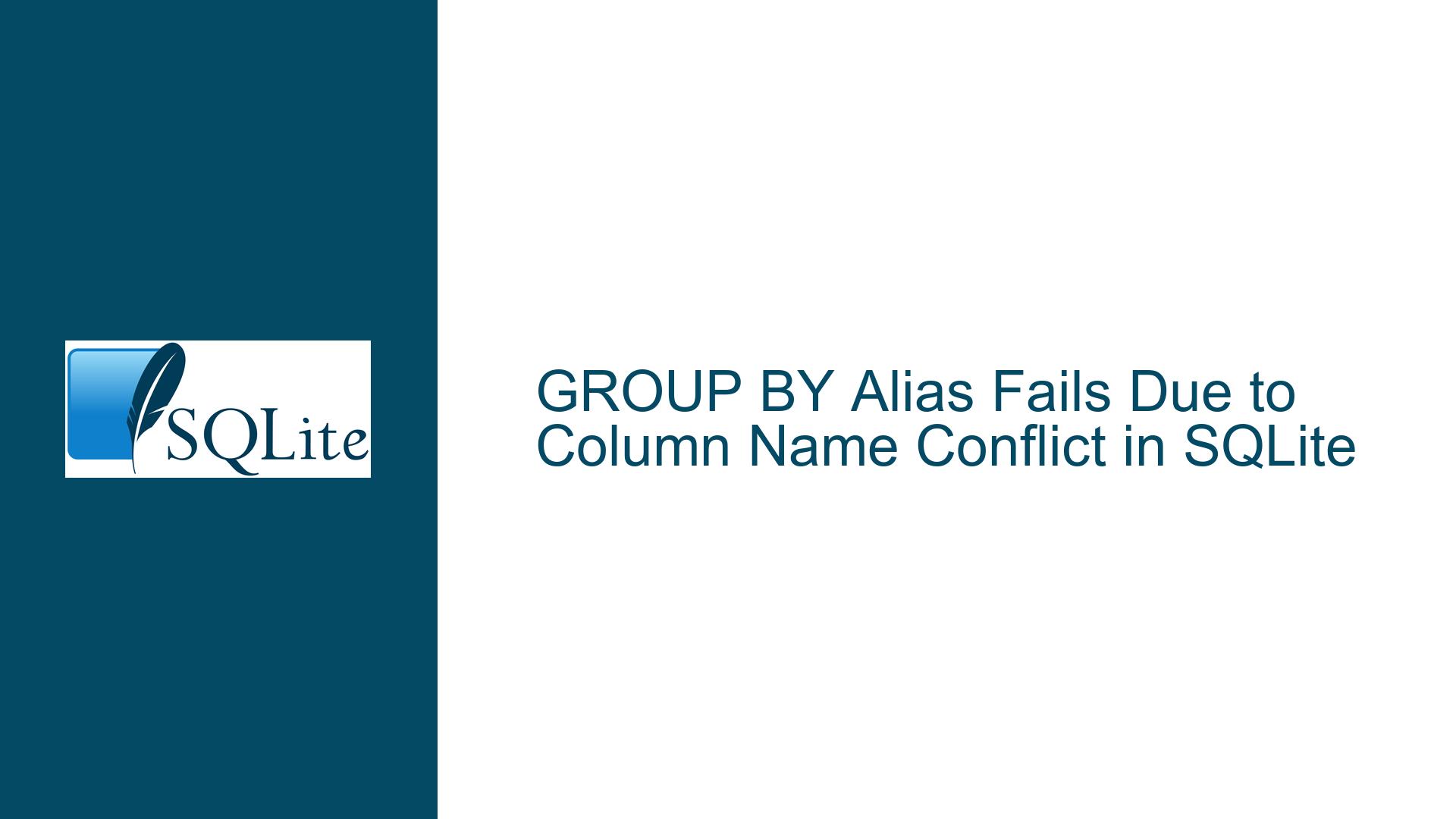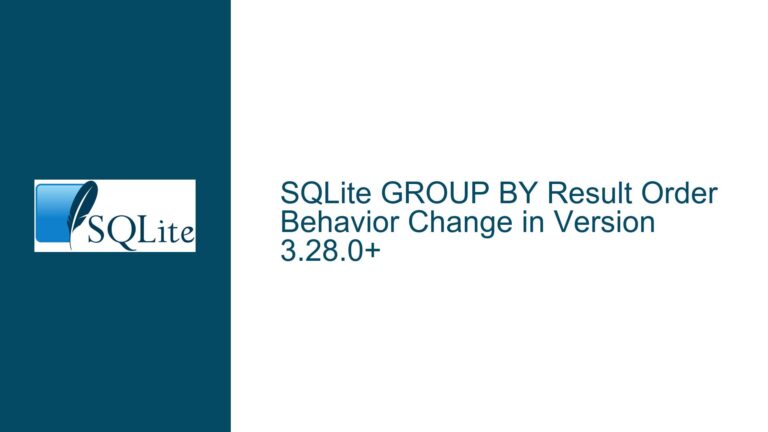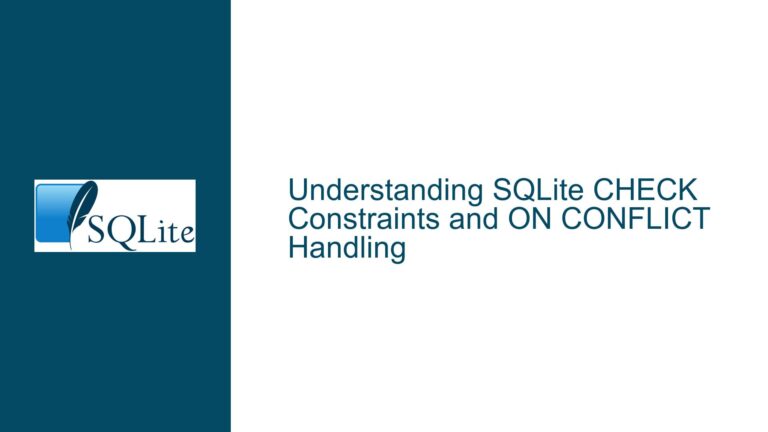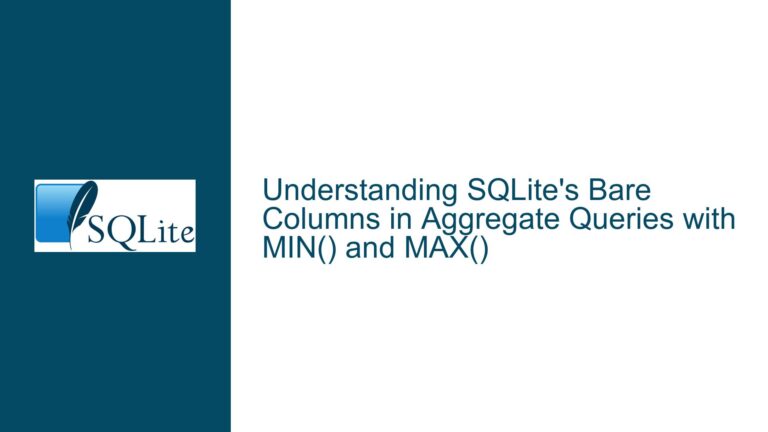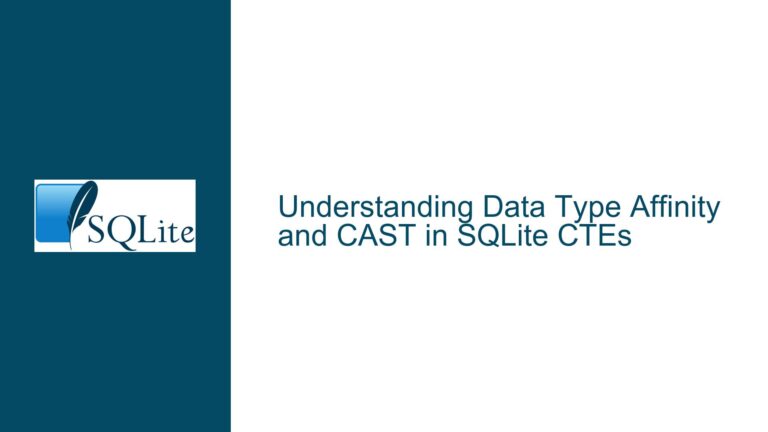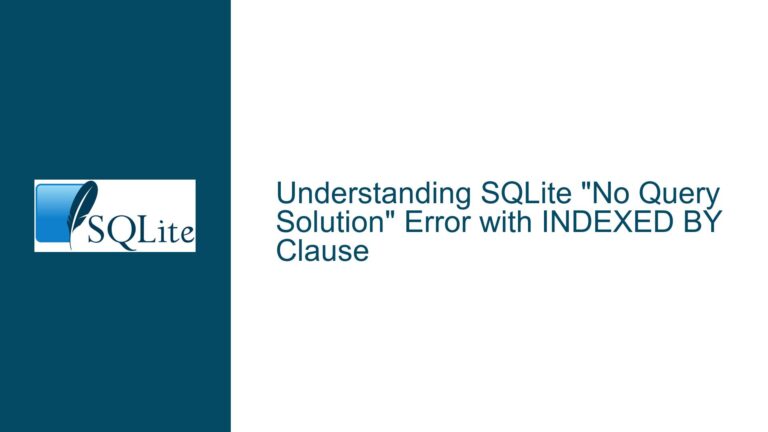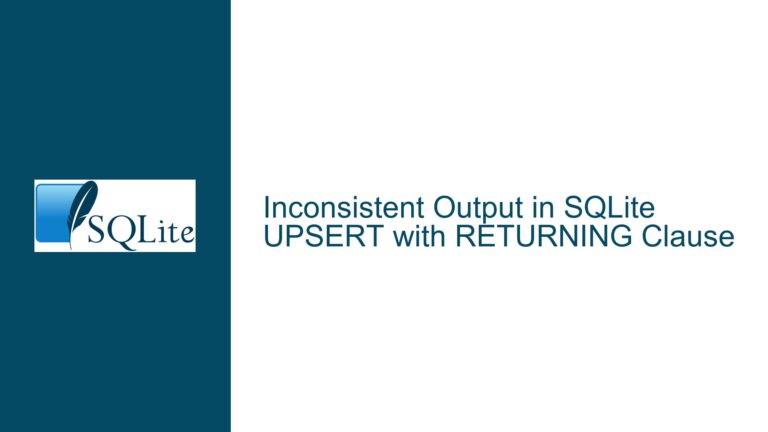GROUP BY Alias Fails Due to Column Name Conflict in SQLite
Understanding the Misalignment Between Aliased Expressions and Existing Column Names in GROUP BY Aggregation
Issue Overview: Ambiguous Column References Causing Incorrect Grouping
The core issue arises when an aliased expression in the SELECT clause shares its name with an existing column in one of the joined tables. SQLite’s scoping rules prioritize resolving identifiers in the GROUP BY clause against column names present in the FROM clause before considering aliases defined in the SELECT clause. This behavior leads to unexpected results when the GROUP BY clause references an alias that unintentionally matches a preexisting column name.
In the provided scenario, the query computes a derived year value using strftime('%Y', datetime(treatments.checkinTime/1000, 'unixepoch')) and aliases it as year. The bibRefCitations table contains a column named year, which is not directly referenced in the SELECT or WHERE clauses. Despite this, the GROUP BY year clause resolves to the bibRefCitations.year column instead of the aliased expression. This results in multiple rows per calendar year because the underlying bibRefCitations.year values differ across joined records, preventing proper aggregation.
The confusion stems from SQLite’s identifier resolution hierarchy:
- Table Columns: Columns explicitly defined in the tables listed in the FROM clause.
- Aliases in the SELECT Clause: Column aliases defined in the SELECT list, but only if they do not conflict with table columns.
When the alias year is used in GROUP BY, SQLite first checks if year exists as a column in any table within the FROM clause. Since bibRefCitations.year exists, it uses this column for grouping instead of the aliased computed value. This creates a mismatch between the intended aggregation key (the computed year from treatments.checkinTime) and the actual grouping key (bibRefCitations.year).
Possible Causes: Identifier Resolution Conflicts and Schema Design Pitfalls
Column Name Collision Between Aliases and Tables
The presence of ayearcolumn inbibRefCitationsdirectly conflicts with the alias assigned to the computed year fromtreatments.checkinTime. SQLite’s parser does not prioritize aliases over table columns in the GROUP BY clause, leading to unintended grouping logic. This conflict is not immediately obvious because the query does not explicitly referencebibRefCitations.year, but the mere existence of the column in the schema triggers the resolution ambiguity.Implicit JOIN Behavior and Cartesian Products
The JOIN betweentreatments,vtreatments, andbibRefCitationsmay produce multiple rows pertreatmentsrecord if there are one-to-many relationships between these tables. When combined with GROUP BY referencingbibRefCitations.year, this amplifies the fragmentation of result rows. For instance, if a singletreatmentsrecord links to multiplebibRefCitationsentries with differentyearvalues, each combination generates a distinct group despite sharing the same computedyearfromtreatments.checkinTime.Overreliance on Positional or Expression-Based GROUP BY
The working alternatives—usingGROUP BY 1(positional reference) or repeating the fullstrftime(...)expression in GROUP BY—avoid the identifier conflict by sidestepping the ambiguousyearalias. Positional references bind strictly to the SELECT list order, while expression-based GROUP BY clauses force SQLite to recompute the value, ignoring column names. These approaches work because they eliminate the ambiguity that arises when relying on the alias name.Schema Design Without Namespace Isolation
ThebibRefCitations.yearcolumn’s generic name increases the risk of naming conflicts in queries involving multiple tables. Columns likeyear,status, ortypeare prone to collision when joined with other tables containing similarly named fields. A schema design that uses more specific column names (e.g.,citationYear,treatmentYear) would mitigate this risk.
Troubleshooting Steps, Solutions & Fixes: Resolving Ambiguity and Ensuring Correct Aggregation
Step 1: Identify Conflicting Column Names
Begin by inspecting the schema of all tables involved in the query to detect columns sharing the alias name. Use the .schema command in the SQLite shell or query PRAGMA table_info(table_name); to list columns for each table. In this case, bibRefCitations.year is the conflicting column.
Step 2: Eliminate Alias-Column Name Overlaps
Rename the alias in the SELECT clause to a name that does not exist in any joined table. For example:
SELECT
strftime('%Y', datetime(treatments.checkinTime/1000, 'unixepoch')) AS checkinYear,
Count(*) AS num
...
GROUP BY checkinYear;
This ensures the GROUP BY references an unambiguous alias.
Step 3: Use Positional GROUP BY References
If modifying aliases is impractical, use positional references in GROUP BY. The first column in the SELECT list is referenced as 1, the second as 2, and so on:
SELECT
strftime('%Y', datetime(treatments.checkinTime/1000, 'unixepoch')) AS year,
Count(*) AS num
...
GROUP BY 1;
This approach bypasses identifier resolution issues by binding directly to the SELECT list order.
Step 4: Repeat the Full Expression in GROUP BY
Explicitly recompute the grouping key in the GROUP BY clause:
SELECT
strftime('%Y', datetime(treatments.checkinTime/1000, 'unixepoch')) AS year,
Count(*) AS num
...
GROUP BY strftime('%Y', datetime(treatments.checkinTime/1000, 'unixepoch'));
This forces SQLite to use the computed value rather than resolving the year identifier against table columns.
Step 5: Subquery Isolation for Alias Precedence
Encapsulate the computation and aliasing in a subquery to elevate the alias’s precedence:
SELECT year, Count(*) AS num
FROM (
SELECT
strftime('%Y', datetime(treatments.checkinTime/1000, 'unixepoch')) AS year
FROM
treatments
JOIN vtreatments ON treatments.treatmentId = vtreatments.treatmentId
JOIN bibRefCitations ON bibRefCitations.treatmentId = treatments.treatmentId
WHERE
vtreatments MATCH 'tyrannosaurus'
AND Lower(treatments.authorityName) LIKE 'osborn%'
AND treatments.deleted = 0
AND bibRefCitations.deleted = 0
) AS subquery
GROUP BY year;
Subqueries create a new scope where aliases in the inner SELECT take precedence over outer table columns.
Step 6: Schema Refactoring for Long-Term Stability
To prevent future conflicts, rename ambiguous columns in the schema. For example, change bibRefCitations.year to bibRefCitations.citationYear:
ALTER TABLE bibRefCitations RENAME COLUMN year TO citationYear;
Update application code and queries to reflect the new column name. This eliminates the root cause of the conflict.
Step 7: Query Optimization with Materialized Expressions
If recomputing strftime(...) in GROUP BY impacts performance, consider persisting the derived year in the treatments table:
ALTER TABLE treatments ADD COLUMN checkinYear INTEGER;
UPDATE treatments SET checkinYear = strftime('%Y', datetime(checkinTime/1000, 'unixepoch'));
CREATE INDEX ix_treatments_checkinYear ON treatments(checkinYear);
Query using the precomputed column:
SELECT checkinYear, Count(*) AS num
...
GROUP BY checkinYear;
Step 8: Educate Team Members on SQLite’s Scoping Rules
Document the identifier resolution hierarchy and promote alias naming conventions that avoid common column names. For example, prefixing aliases with the table or context (e.g., treatmentsYear, computedYear).
Step 9: Utilize Linting Tools for Early Detection
Integrate SQL linters or IDE plugins that flag column-alias name conflicts during query development. Tools like sqlfluff or custom scripts can parse queries and compare aliases against table schemas.
Step 10: Regression Testing for Query Logic
Implement automated tests that validate the row count and aggregation results of critical queries. For instance, assert that grouping by the computed year always produces one row per distinct year, regardless of input data permutations.
